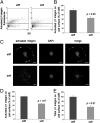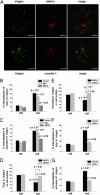Integrin activation and internalization on soft ECM as a mechanism of induction of stem cell differentiation by ECM elasticity
- PMID: 21593411
- PMCID: PMC3111285
- DOI: 10.1073/pnas.1106467108
Integrin activation and internalization on soft ECM as a mechanism of induction of stem cell differentiation by ECM elasticity
Abstract
The mechanism by which ECM elasticity induces lineage specification of stem cells has not been clearly understood. Integrins are well-documented mechanosensors that are positioned at the beginning of the sensing pathway. By using an antibody specifically recognizing the active conformation of β1 integrin, we observed that β1 integrin activation in bone marrow mesenchymal stem cells (BMMSCs) was induced by soft substrate to a significantly greater degree than by stiff substrate. In contrast, however, the level of cell surface integrin on soft substrate was significantly lower than that on stiff substrate. Soft substrate markedly enhanced the internalization of integrin, and this internalization was mediated mainly through caveolae/raft-dependent endocytosis. The inhibition of integrin internalization blocked the neural lineage specification of BMMSCs on soft substrate. Furthermore, soft substrate also repressed the bone morphogenetic protein (BMP)/Smad pathway at least partially through integrin-regulated BMP receptor endocytosis. A theoretical analysis based on atomic force microscopy (AFM) data indicated that integrin-ligand complexes are more easily ruptured on soft substrate; this outcome may contribute to the enhancement of integrin internalization on soft substrate. Taken together, our results suggest that ECM elasticity affects integrin activity and trafficking to modulate integrin BMP receptor internalization, thus contributing to stem cell lineage specification.
Conflict of interest statement
The authors declare no conflict of interest.
Figures






Similar articles
-
Integrin endocytosis on elastic substrates mediates mechanosensing.J Biomech. 2016 Sep 6;49(13):2644-2654. doi: 10.1016/j.jbiomech.2016.05.024. Epub 2016 Jun 2. J Biomech. 2016. PMID: 27344201
-
Beta 1 integrin binding plays a role in the constant traction force generation in response to varying stiffness for cells grown on mature cardiac extracellular matrix.Exp Cell Res. 2015 Jan 15;330(2):311-324. doi: 10.1016/j.yexcr.2014.09.007. Epub 2014 Sep 16. Exp Cell Res. 2015. PMID: 25220424
-
Mechanotransduction of matrix stiffness in regulation of focal adhesion size and number: reciprocal regulation of caveolin-1 and β1 integrin.Sci Rep. 2017 Nov 8;7(1):15008. doi: 10.1038/s41598-017-14932-6. Sci Rep. 2017. PMID: 29118431 Free PMC article.
-
Caveolae internalization regulates integrin-dependent signaling pathways.Cell Cycle. 2006 Oct;5(19):2179-82. doi: 10.4161/cc.5.19.3264. Epub 2006 Oct 1. Cell Cycle. 2006. PMID: 16969102 Review.
-
Extracellular matrix, integrins, and growth factors as tailors of the stem cell niche.Curr Opin Cell Biol. 2012 Oct;24(5):645-51. doi: 10.1016/j.ceb.2012.07.001. Epub 2012 Aug 13. Curr Opin Cell Biol. 2012. PMID: 22898530 Review.
Cited by
-
On human pluripotent stem cell control: The rise of 3D bioengineering and mechanobiology.Biomaterials. 2015 Jun;52:26-43. doi: 10.1016/j.biomaterials.2015.01.078. Epub 2015 Feb 21. Biomaterials. 2015. PMID: 25818411 Free PMC article. Review.
-
Effect of mechanical forces on cellular response to radiation.Radiother Oncol. 2022 Nov;176:187-198. doi: 10.1016/j.radonc.2022.10.006. Epub 2022 Oct 10. Radiother Oncol. 2022. PMID: 36228760 Free PMC article. Review.
-
Caveolae as plasma membrane sensors, protectors and organizers.Nat Rev Mol Cell Biol. 2013 Feb;14(2):98-112. doi: 10.1038/nrm3512. Nat Rev Mol Cell Biol. 2013. PMID: 23340574 Review.
-
Single molecular force across single integrins dictates cell spreading.Integr Biol (Camb). 2015 Oct;7(10):1265-1271. doi: 10.1039/c5ib00080g. Epub 2015 Jul 6. Integr Biol (Camb). 2015. PMID: 26143887 Free PMC article.
-
The Myofibroblast Fate of Therapeutic Mesenchymal Stromal Cells: Regeneration, Repair, or Despair?Int J Mol Sci. 2024 Aug 9;25(16):8712. doi: 10.3390/ijms25168712. Int J Mol Sci. 2024. PMID: 39201399 Free PMC article. Review.
References
Publication types
MeSH terms
Substances
Grants and funding
LinkOut - more resources
Full Text Sources
Other Literature Sources
Medical
Miscellaneous

